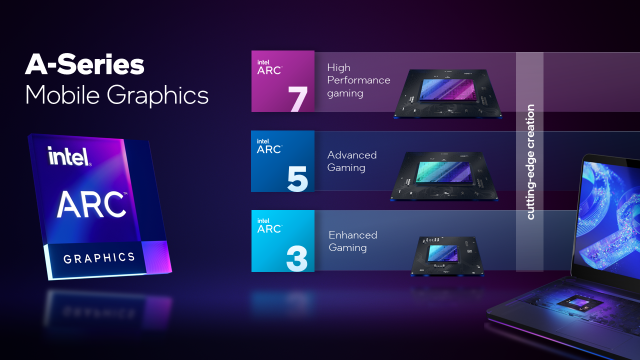Intel’s highly anticipated Arc discrete graphics have arrived, and they intend to disrupt a long-running two-horse race between Nvidia and AMD.
Intel is building its portfolio of graphics cards from the bottom up, starting with an entry-level card for ultra-thin laptops before the release of high-performance GPUs later this year.
Entry-level gaming for portable laptops
For now, the spotlight is on Arc 3, an evolution of Intel’s Iris Xe integrated graphics for portable devices like the upcoming Samsung Galaxy Book2 Pro. Consisting of A350M and A370M chips, Arc 3 is meant to give portable systems the graphics punch needed to play most modern games at 1080p, not to dethrone the top GPUs from Nvidia or AMD.

Arc 3 is said to deliver roughly 2x performance over integrated Iris Xe graphics, making it comparable to other entry-level cards on the market. According to Intel, the higher-end A370M mated with a Core i7-12700H CPU can play popular games like Hitman III, Destiny 2, The Witcher, and Total War: Saga Troy at more than 60 frames per second with the graphics set to Medium. Less demanding titles like Doom Eternal and Strange Brigade should run smoothly on High settings. We’ll need to conduct our own testing before making any definitive claims but it seems the Arc 3 A370M will slot somewhere between Nvidia’s MX450 and RTX 3050 cards when looking at sheer gaming performance.
Intel didn’t provide us with any comparison benchmarks between these Arc A-series GPUs and the current market leaders from AMD and Nvidia. We should learn more when the company highlights Arc 5 and Arc 7 graphics later this year.
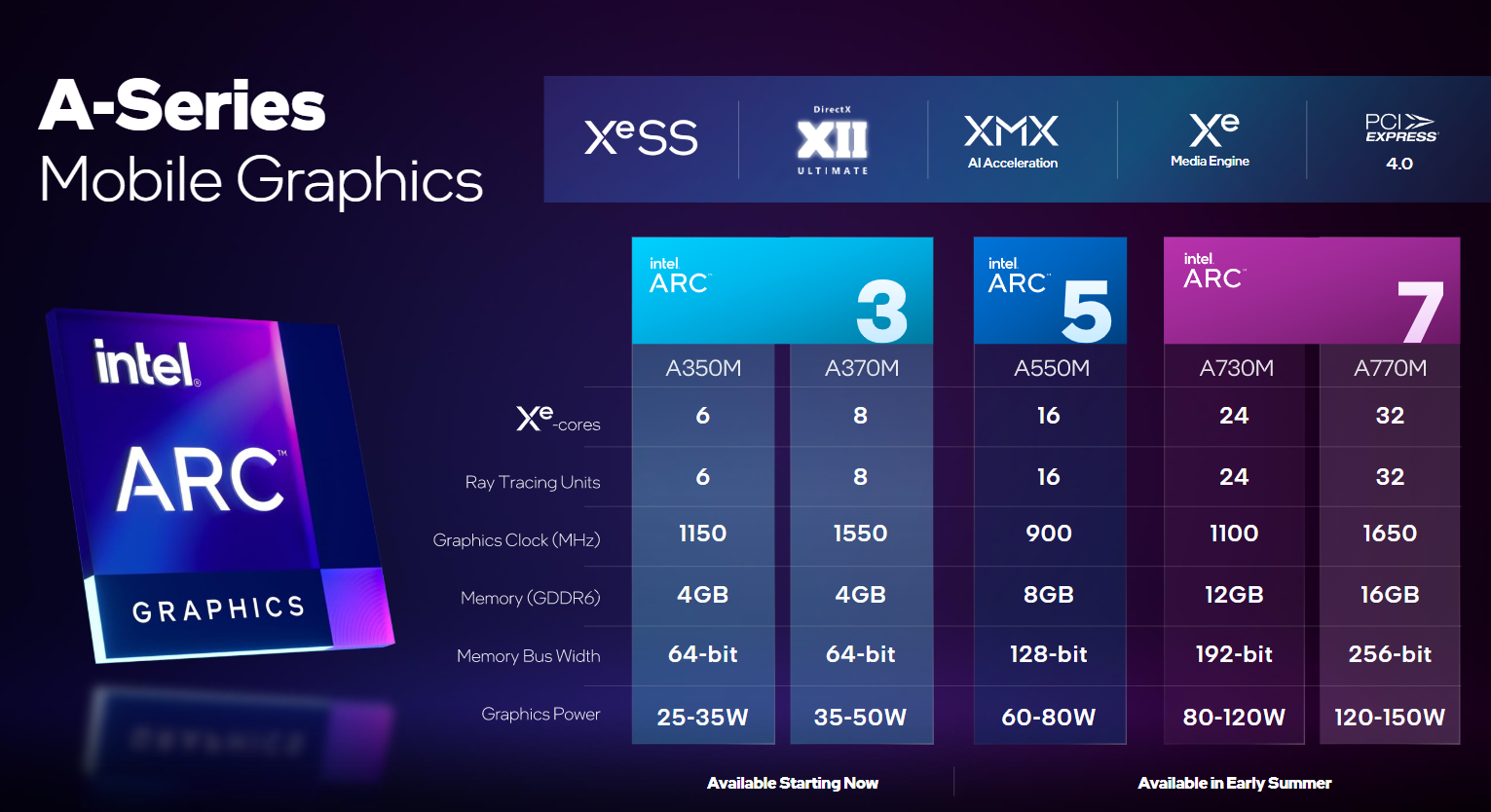
Until then, we’ll have to nibble on some specs. The entry-level Arc 3 A350M has six Xe-cores, six ray tracing units, a clock speed of 1150MHz and supports 4GB of GDDR6 memory at a power level of between 25W and 35W. The Arc 3 A370M requires up to 50W but comes with eight Xe and ray tracing cores and a clock speed of 1550MHz.
Moving up to the mid-range chip, the Arc 5 A550M has 16 cores, 16 ray tracing units, a graphics clock of 900MHz, and 8GB of GDDR6 RAM at between 60 and 80W. At the top of the stack are two Arc 7 chips: the A730M and A770M. The former, an 80-120W chip, has 24 cores, 24 RT units, an 1100 MHz clock, and 12GB of RAM while the most powerful Intel Arc GPU has 32 Xe cores, 32 RT units, a 1650MHz clock, 16GB of GDDR6 RAM, and a 256-bit memory bus width at 120-150W.
The technical bits
Each of these chips is based on Intel’s new Xe HPG microarchitecture, which consists of up to eight render slices, or how configurations scale from low power solutions to enthusiast-class gaming rigs. Within each of these slices are Xe cores, each configured with a set of 256-bit vector engines designed to accelerate traditional graphics and compute workloads, 1024-bit matrix (or XMX) engines for accelerating AI workloads, and 192KB of shared L1/SLM cache.
Intel’s first discrete GPU offerings might not be the performance beasts some had anticipated, but they support a smattering of modern gaming features nonetheless. Every Intel Arc GPU fully supports DirectX 12 Ultimate, a collection of technologies found in modern graphics cards. These include ray tracing (hardware accelerated on Arc GPUs), variable-rate shading, mesh shading, and sampler feedback.
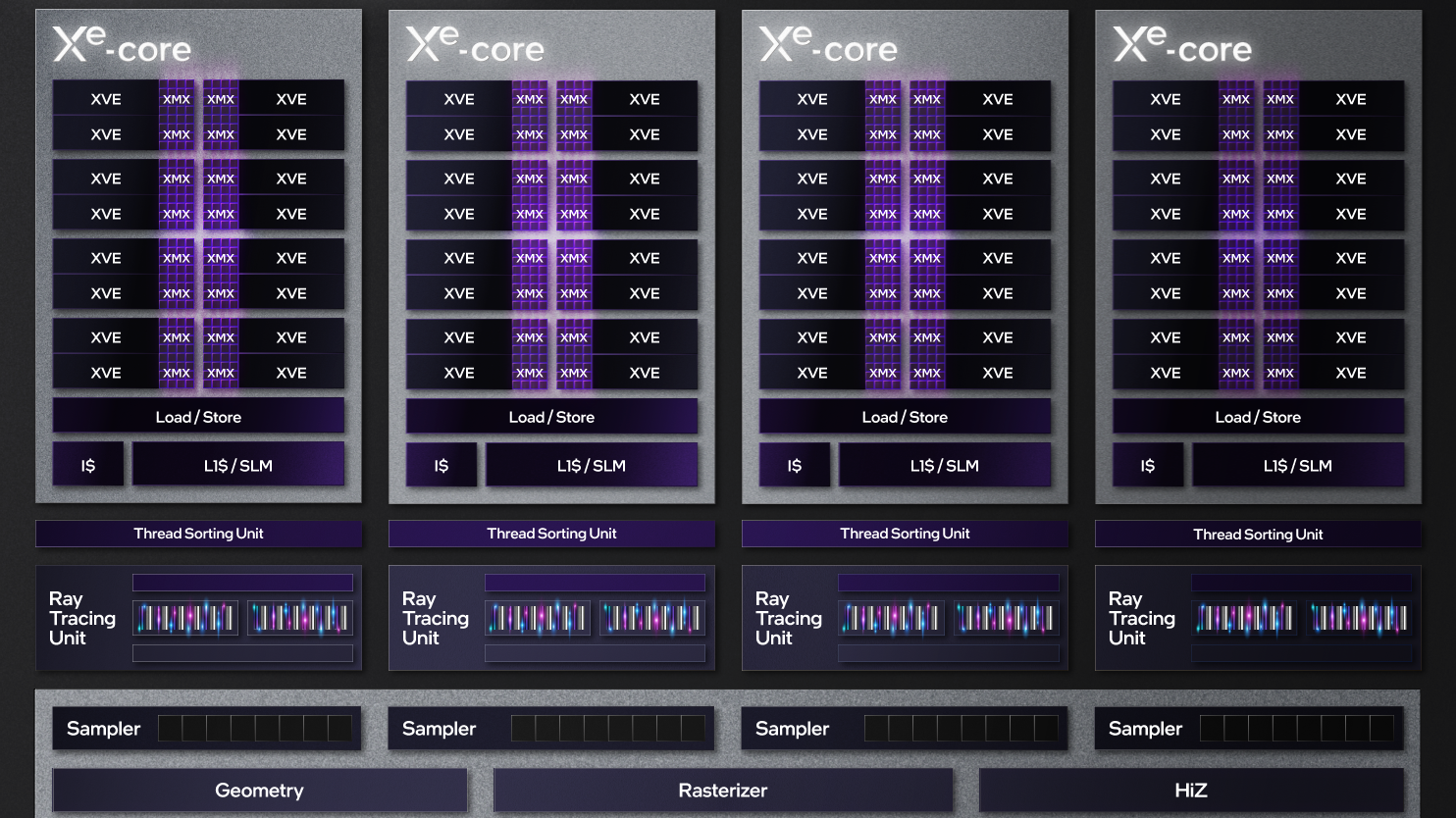
Intel is also bringing its own version of Nvidia’s DLSS. Called Xe Super Sampling, or XeSS, this AI-enabled feature upscales a low-res image to improve graphics quality. This way, you can run a game at a high refresh rate on 1080p but the resolution will appear closer to 4K. In a demo, the XeSS-enhanced video of the upcoming game Dolmen looked noticeably sharper than the untouched gameplay, even through a Zoom call. I can’t say for certain how it compares against AMD and Nvidia’s version, but Intel was transparent about this being nascent technology that it will refine over the years.
The “display engine” in these Arc graphics supports HDMI 2.0b, not the latest HDMI 2.1 standard. We’ve asked Intel to explain the omission and will update this article if we hear back. Still, you can achieve up to two 8K HDR streams at 60 fps, four 4K HDR streams at 120Hz, or 1080p and 1440p at 360Hz through DisplayPort 1.4.
Rounding out the extensive suite of graphics features is a trio of technologies designed to reduce screen tear. The first is one you might already be familiar with: Adaptive Sync adjusts the refresh rate of a display to the GPU frame output to eliminate tearing and stuttering. It is augmented with Speed Sync, a technique to speed up the latest frame in order to reduce latency, and Smooth Sync, which minimizes the jarring visuals of a screen tear by using a blur effect where the two distinct frames meet.
Intel Arc brings AV1 support
Discrete GPUs aren’t only meant for gaming, but also for content creation workflows like video and photo editing. Intel is hoping to entice the non-gaming crowd with support for a wide range of video codecs, including VP9, AVC, HEVC, and AV1 — the most significant addition. Intel claims these chips are the first to offer AV1 hardware-accelerated encoding and decoding.
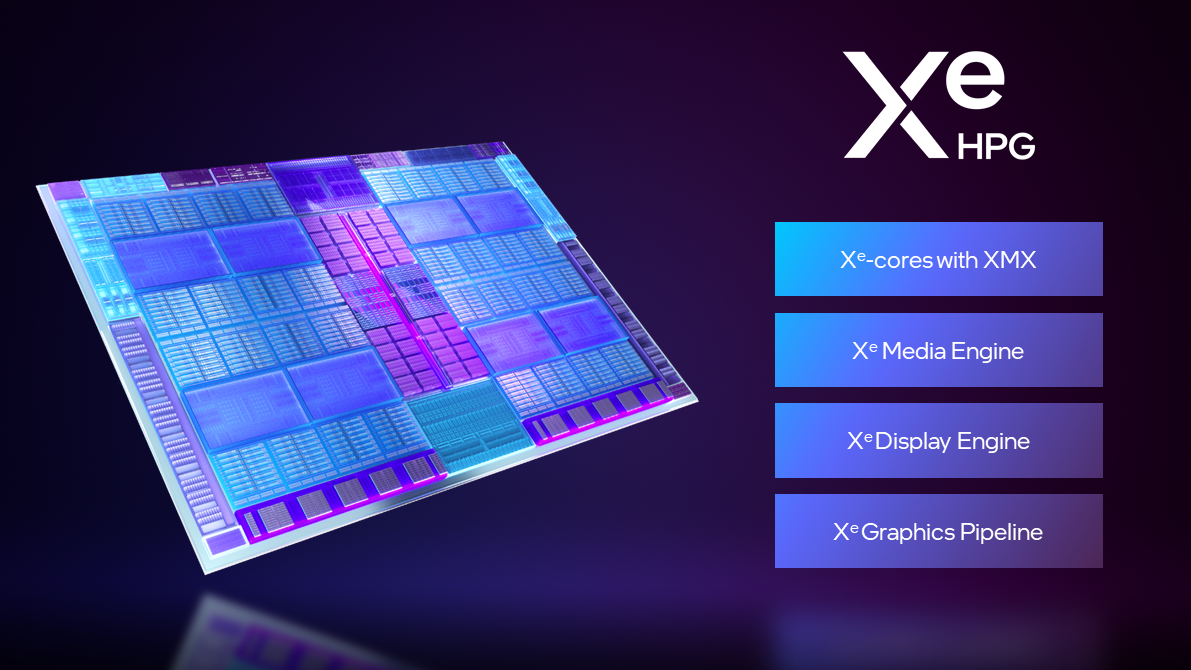
If this is all gibberish, AV1 is an open-source, royalty-free video codec backed by some of the world’s largest tech companies. Already supported by Netflix and YouTube, AV1 is said to be 50% more efficient than today’s most common codec, H.264, and 30% more capable than H.265, meaning it uses less data to offer the same video quality or can enable better video quality using the same amount of data. In practice, hardware acceleration makes the Arc GPUs up to 50x faster at encoding when using popular apps like Handbrake, Adobe Premiere Pro, and DaVinci Resolve, according to Intel.
Intel Arc software and upcoming laptops
Laptops and desktops outfitted with Intel Arc graphics will come with Intel’s Arc Control software, a free program where you can download the latest drivers, view the performance of your machine, adjust settings, and visit your game library.
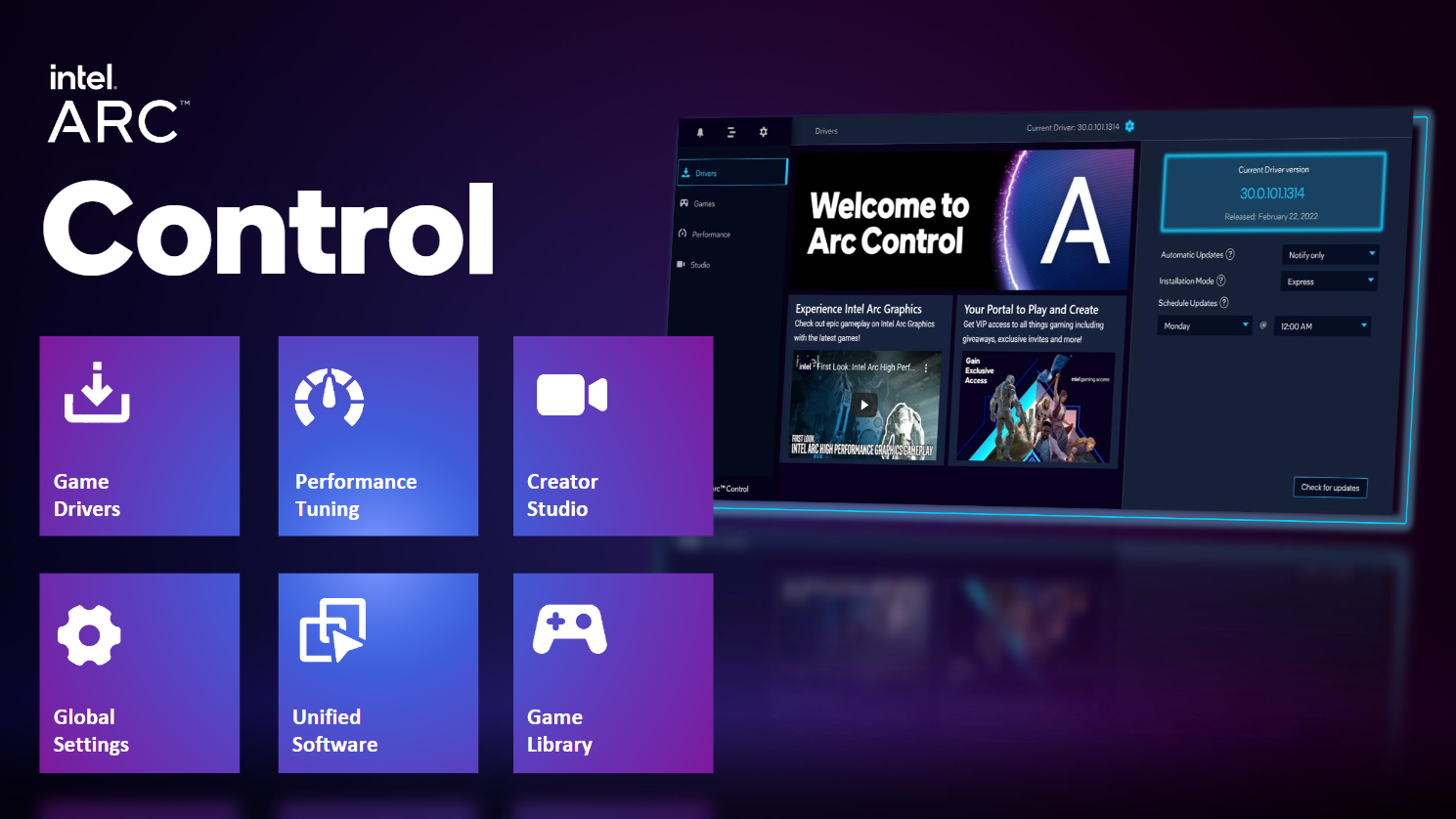
You’ll be able to open the program using an Alt + I shortcut and it’ll appear as an overlay so you don’t get booted from your game. Arc Control consists of six areas: Game Drivers, Performance Tuning, Creator Studio, Global Settings, Unified Software, and Game Library. I won’t go through each of them, but some highlights include a telemetry overlay to see hardware statistics and the ability to broadcast to third-party platforms and use your integrated webcam with AI features like background blur.
Intel says Arc 3 laptops are available starting today beginning with the Samsung Galaxy Book2 Pro. The first batch of Arc-powered systems will be Intel Evo-certified, meaning they are thin and lightweight systems with at least nine hours of battery life (based on Intel’s own testing methods, we should caution). We’ll put Intel Arc through its paces the moment the first Arc 3-powered laptop arrives at our door. Gamers and content creators eager to see how Intel competes more directly with Nvidia and AMD will find out in early summer when Arc 5 and Arc 7 are released.
